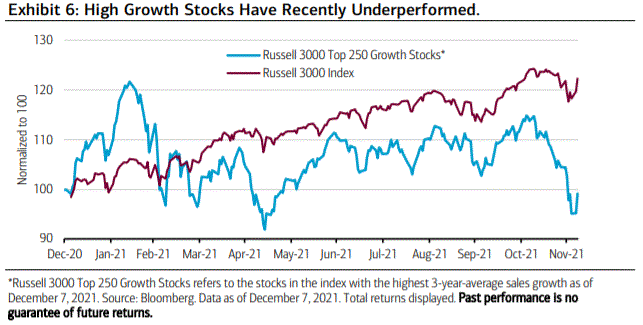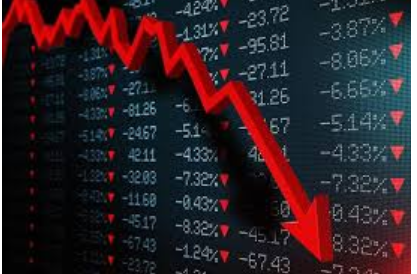Merrill fokuserer i en analyse på vækstaktierne og konstaterer, at de har fået et voldsomt dyk i november. Det er især vækstaktier med lav indtjening og negativ cash flow, som er blevet handlet ned, men det hænger også sammen med, at mange investorer nu forlader vækstaktierne efter et par forrygende år. En strammere pengepolitik og udsigt til en højere rente vil tælle nedad for vækstaktierne. Men Merrill tror dog, at mange vækstaktier vil komme op igen. Merrill anbefaler vækstaktier , men kun hvis investorerne satser på kvalitetsaktier med en høj indtjening og med et mellemlangt sigte.
High-Growth Stocks Are Stalling
High-growth and extremely high-valuation stocks experienced some sharp pullbacks in
recent weeks (Exhibit 6). Drilling down a bit further, we find that Growth stocks with low
profitability and negative free cash flows have been hit particularly hard. We see a few
reasons for this dip, including a more hawkish Fed, increased expectations for elevated
inflation and interest rates, and end-of-year shifts in investor positioning.

In recent weeks, investors have digested a variety of economic data suggesting that
higher levels of inflation are here to stay. Fed Chairman Jerome Powell recently added to
expectations that inflation will be persistent by retiring the use of the word ‘transitory.’ As
a result, investors are anticipating an accelerated tapering timeline and a pull forward in
forecasts for interest rate hikes. High-valuation stocks historically see multiple
compression when interest rate expectations rise and actual interest rates move higher.
The confluence of these developments has likely weighed on high-growth stocks.
Higher inflation paired with higher interest rates creates an unfavorable backdrop for
highgrowth and high-valuation equities, as they typically have long durations and high valuation
multiples. Their price is largely tied to their terminal value since they have limited nearterm profits,
so an increase in the discount rate (interest rate) has a direct and immediate
negative effect on present value. It’s been a while since investors have experienced this
type of environment, and signals that we’re potentially moving toward it have created
some tremors in the high-growth area of the market.
Shifts in investor positioning are also a likely factor for the recent sell-off. Long-term
holders of these equities may be selling to try to lock in profits that have accrued during
the drawn-out stretch of relative outperformance for Growth stocks. In addition, many of
these high-growth stocks are crowded positions—meaning they are stocks owned by
many different investors including large institutional investors, hedge funds, passive funds
and retail investors. There may have been some forced selling by institutional investors
when these stocks turned sharply lower and started to threaten year-end portfolio
performance.
On balance, we continue to suggest appropriate allocations to Growth as part of a
disciplined long-term financial strategy. Investors may want to consider emphasizing highquality
Growth equities with strong earnings and medium durations, when appropriate.

